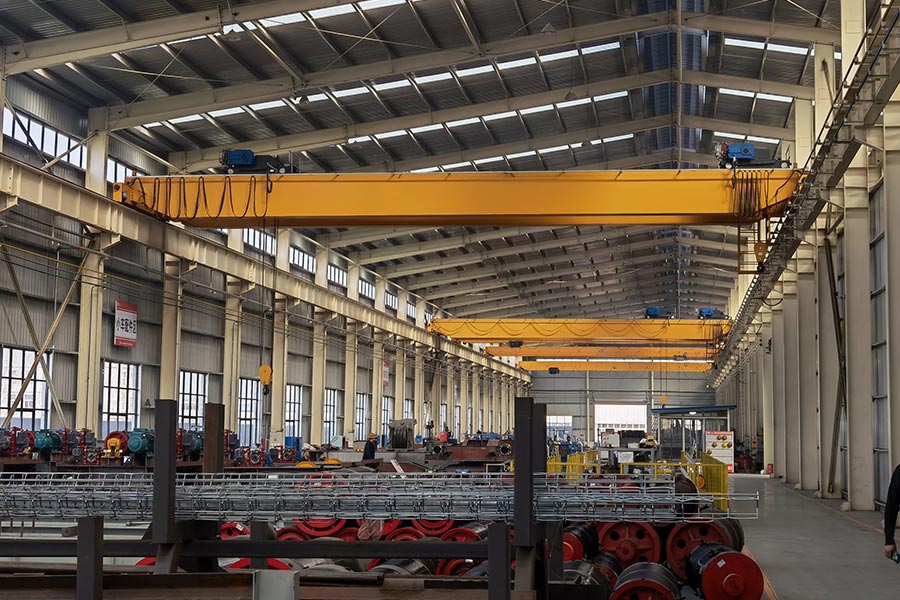In today’s industrial world, efficiency and flexibility are key factors in optimizing operations, particularly when it comes to lifting heavy loads. Double girder overhead cranes have long been a go-to solution for lifting and moving heavy materials, but with advancements in crane technology, dual hoist systems have emerged as a powerful enhancement to these already highly capable machines. By incorporating two hoists into one crane system, industries can unlock new levels of versatility, productivity, and safety.
In this article, we will explore the benefits of dual hoist systems in a double girder overhead crane, discussing how these systems improve lifting flexibility and help industries address the complexities of modern lifting needs. We will also cover the main components of dual hoist systems, their applications, and considerations when selecting or installing such a system.

What is a Dual Hoist System?
A dual hoist system is an advanced feature integrated into double girder overhead cranes. It involves the installation of two hoists, typically of the same or different capacities, on the same crane. These hoists are mounted on the crane’s two parallel girders and are operated independently or in unison, providing a significant increase in lifting flexibility and capacity.
The dual hoist system allows for the simultaneous handling of multiple loads, each from a different hoist, or the ability to handle a heavier load by combining the lifting capacities of both hoists. This can be especially useful in industries that deal with irregularly shaped or oversized materials, as well as when the lifting requirements demand more precision or greater lifting height.
Key Benefits of Dual Hoist Systems
1. Enhanced Lifting Capacity
The most obvious advantage of a dual hoist system is the increase in lifting capacity. By incorporating two hoists on a double girder overhead crane, the system can handle much heavier loads than a single hoist crane. This is particularly useful in applications where larger or heavier materials need to be moved regularly, such as in steel mills, shipyards, construction sites, and heavy machinery handling facilities.
For instance, a dual hoist crane can handle a combined load, say 40 tons (using two 20-ton hoists), which allows businesses to lift heavier items without needing to invest in multiple 20 ton overhead cranes or complex lifting systems.
2. Improved Flexibility
A dual hoist system provides flexibility in lifting operations. Each hoist can be used independently for lighter loads, or both can work together to lift heavier loads. This flexibility is essential in environments where different lifting tasks are required within the same operation. For example, one hoist might be used to lift a steel beam, while the other is used for lifting smaller items, such as tools or machinery parts.
Additionally, the dual hoist system allows for the lifting of asymmetric loads. If a load is unevenly distributed, both hoists can work together to balance the load, reducing the risk of damage to materials or the crane. This flexibility ensures that operators can complete a wide range of tasks with a single crane.

3. Increased Productivity
With the ability to lift two loads simultaneously or to handle heavier, combined loads, dual hoist systems can significantly increase operational productivity. In industries where time is critical, having the ability to lift multiple loads at once can reduce downtime and enhance workflow efficiency.
For instance, in warehouses, manufacturing plants, and shipping yards, dual hoist cranes can expedite loading and unloading operations, leading to faster turnaround times and better overall efficiency. This can be especially advantageous in high-volume environments where every second counts.
4. Improved Safety
Safety is paramount in heavy lifting operations, and dual hoist systems contribute to reducing the risk of accidents. The independent operation of each hoist allows for more precise control of the load, particularly in situations where the load is large, heavy, or delicate.
In addition, dual hoist systems are often equipped with advanced safety features such as load limiters, anti-sway technology, and overload protection. These safety measures ensure that the lifting process is smooth and controlled, even when handling complex or non-uniform loads.
Furthermore, dual hoist systems can reduce the need for additional personnel or cranes in some lifting tasks, lowering the potential for accidents associated with overcrowding and miscommunication during lifting operations.
5. Greater Control and Precision
A dual hoist system provides operators with enhanced control over lifting operations. By using two hoists, operators can adjust the speed, position, and angle of each hoist, which helps achieve greater precision when positioning heavy or delicate items.
This control is particularly useful when lifting large beams, machinery, or other oversized materials that require careful handling. By fine-tuning each hoist’s operation, the hoist overhead crane can achieve more accurate load placement, reducing the likelihood of errors or damage.
6. Versatility in Handling Multiple Loads
In facilities where multiple items need to be moved simultaneously, dual hoist cranes provide a versatile solution. These cranes are capable of lifting two different types of loads at the same time, such as moving a heavy container while also lifting smaller components, increasing the overall productivity of the operation.
The ability to handle multiple loads at once eliminates the need for additional cranes, reducing equipment costs and space usage within the facility.
Applications of Dual Hoist Systems
Dual hoist systems are widely used in industries that demand heavy lifting and versatility. Some of the most common applications include:
-
Steel Mills: Handling large steel beams, coils, and other heavy components.
-
Shipbuilding and Shipyards: Lifting large, heavy materials such as ship hulls, engines, and other oversized items.
-
Construction Sites: Lifting structural components, heavy machinery, and building materials.
-
Automotive and Aerospace Manufacturing: Moving large parts and components in assembly lines or testing areas.
-
Energy Sector: Lifting heavy equipment, turbines, and other critical components in power plants and energy facilities.
-
Warehouses and Distribution Centers: Handling heavy pallets, containers, or machinery parts in a storage or shipping environment.
Considerations When Installing a Dual Hoist System
While the benefits of dual hoist systems are clear, there are several important factors to consider when selecting or installing such a system:
1. Load Requirements
Before installing a dual hoist system, it’s crucial to determine the maximum load capacity required for the operation. This includes considering the weight of the materials to be lifted, as well as any potential overloads or extreme conditions that may arise during the lifting process.
2. Space Availability
Dual hoist systems require more space than single hoist systems due to the added hoist and its supporting mechanisms. It’s important to ensure that the double girder eot crane and its installation site have enough space to accommodate the system, including the tracks, girders, and hoist movement.
3. Maintenance and Inspections
With the added complexity of dual hoist systems, regular maintenance and inspections become even more important. Operators should ensure that both hoists are properly maintained to avoid wear and tear, misalignment, or other issues that could affect the crane’s performance and safety.
4. Control Systems
A dual hoist system requires an advanced control system to operate the two hoists in coordination. Ensuring the crane’s control system is properly calibrated and equipped with safety features, such as overload protection and synchronization control, is essential for smooth and safe operations.
Conclusion
Dual hoist systems in double girder overhead cranes offer a significant enhancement in lifting flexibility, safety, and productivity. By allowing the simultaneous or independent operation of two hoists, industries can handle heavier loads, increase operational efficiency, and improve the precision of lifting tasks. These systems are a valuable asset in environments where versatility and heavy lifting are critical, making them an excellent choice for industries ranging from construction to manufacturing and beyond.
As the demands of modern industries continue to evolve, the adoption of dual hoist systems will likely continue to rise, providing businesses with the tools they need to meet the challenges of today’s fast-paced and complex lifting operations.
